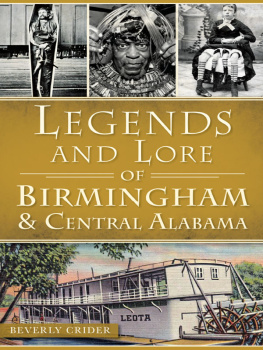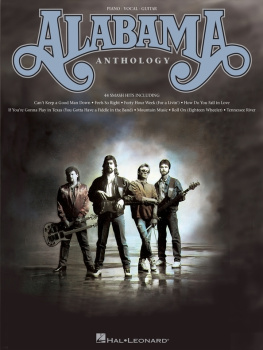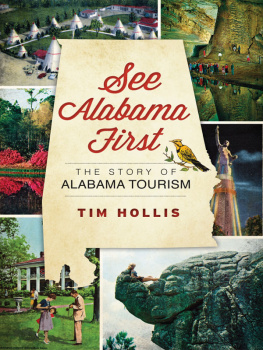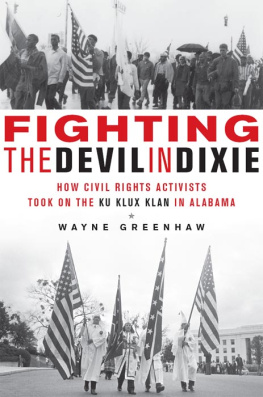

Published by The History Press
Charleston, SC 29403
www.historypress.net
Copyright 2014 by Beverly Crider
All rights reserved
Unless otherwise noted, images come from the public domain.
First published 2014
e-book edition 2014
ISBN 978.1.62584.927.4
Library of Congress Cataloging-in-Publication Data
Crider, Beverly.
Legends and lore of Birmingham and central Alabama / Beverly Crider.
pages cm
Includes bibliographical references.
print edition ISBN 978-1-62619-396-3
1. Alabama--History, Local--Anecdotes. 2. Alabama--Social life and customs--Anecdotes. 3. Alabama--Biography--Anecdotes. 4. Folklore--Alabama. 5. Legends--Alabama. 6. Birmingham (Ala.)--History--Anecdotes. 7. Birmingham (Ala.)--Social life and customs--Anecdotes. I. Title.
F326.6.C75 2014
976.1--dc23
2014004791
Notice: The information in this book is true and complete to the best of our knowledge. It is offered without guarantee on the part of the author or The History Press. The author and The History Press disclaim all liability in connection with the use of this book.
All rights reserved. No part of this book may be reproduced or transmitted in any form whatsoever without prior written permission from the publisher except in the case of brief quotations embodied in critical articles and reviews.
CONTENTS
INTRODUCTION
Southerners are generally known for the ability to spin a good yarn. Im certainly known for my gift of gab, but that yarn-spinning thingwell, lets just say Im no Kathryn Tucker Windham. Thats for sure! As Twitter, Facebook, Instagram and other real-time forms of communication have taken control of our lives, forcing us to condense, abbreviate and otherwise cut our messages down to the bare bones, Im afraid that the ability to tell a good tale may eventually become even harder to find than it is today.
I remember my early attempts at writing when I was in elementary school. I let my imagination run wild, and my schoolteachers encouraged me. I remember standing in front of my classmates reading my latest attempt at a short story, and I just knew that one day I would write an exciting full-length novel. As I began journalism classes in college, I had to stop myself from using too many adjectives or going into too much detail when writing a news story. Even way back then, before the fast-paced Internet newsfeeds, we were already becoming impatient readers. It was really difficult in the beginning. Then, somewhere along the way, I discovered that the short-handed approach had become the way I wrote everything. I found myself constantly editing the words on the page, making the final product shorter and shorter to fit the requirements of the media. When I attempted to write more creative pieces, I found myself questioning the need for all those words. (Which is a laugh, because I have no such qualms about using words in conversation, as anyone who knows me can confirm.)
As we lose our storytellers, we lose our stories. That might sound pretty obvious, but think about it. Gone are the days of sitting on the porch, shooting the breeze. Our stories are becoming more homogenous as a nation. Thats not necessarily a bad thing, but it would be nice to keep some of those regional stories alive. So, let me cut to the chase and move things along. While this is not a detailed, comprehensive volume about Central Alabamas people, places and things, I hope you will find it somehow bridges the gap between todays status updates and yesterdays handwritten letters.
CHAPTER 1
MUMMY DEAREST
Strapped to the sideboard of a Ford Model-T, Hazel the Mummy bounced down the roads of Alabama and beyond, bringing a hefty income of $150$200 per week for her owner, Orlando Clayton Brooks, during the early part of the twentieth century. How, exactly, Hazel became a mummy is the stuff legends are made of.
Hazel Farris was born sometime around 1880 in Kentucky. As a young newlywed, some twenty years later, Harris had developed quite the knack for spending money. Some say she was particularly fond of hats. Apparently, she purchased (or expressed interest in purchasing) one hat too many, over which her husband became outraged. On the morning of April 6, 1905, during a struggle that ensued over the hat purchase, Hazel shot and killed her husband. Three policemen happened to be walking by and heard the shots. When they arrived at the home, they found Hazel standing over her husbands body holding a gun. She shot the three officers as well.
By now, quite a crowd had gathered. The deputy sheriff tried to take her in to custody but succeeded only in shooting off the ring finger of one of her hands before she returned a deadly shot. She fled her pursuers and made her way to Bessemer, Alabama, where she took up new residence. There is some question as to how she portrayed herself to the public in her new home, although consensus seems to be that she worked as a prostitute and was known to drink heavily.
Hazel must have felt alone in this new town and developed the need to share the details of her past with someone. Unfortunately for her, she chose her new beaux, who apparently was a policeman. Law won out over love, and he turned her in. Rather than go to jail, she decided to kill herself. On December 20, 1906, she drank a fatal combination of alcohol and what many have concluded was arsenic.
Hazels body was taken to a nearby furniture store, which served as a makeshift funeral parlor, as many furniture stores did during that time. No one claimed her body, and as it lay in the back of the store, it began to decay (or not decay) in a most unusual way. The skin became dried and tightly drawn over her skeletal remains. Some claimed her hair and nails continued to grow, although today we realize it is actually the skin receding, making the hair and nails appear to be longer.
The store owner saw the opportunity to cash in on the notoriety of the case and offered anyone interested the chance to see Hazel, propped up against a wall in the back of the store, for a mere ten cents. He then sent the mummy by train to his brother in Tuscaloosa so he could display her in the same manner.
Captain Harvey Lee Boswell (not to be confused with Lee Harvey Oswald) also exhibited Hazels remains before traveling showman O.C. Brooks purchased the body for twenty-five dollars in May 1907.
With ticket sales bringing Brooks such a nice income, Hazels ride was upgraded to a 1931 Oldsmobile. Brooks continued to show the mummy for another forty years. His printed handbills claimed the body was exhibited for the benefit of science.
What mummy is not going to develop certain rumored powers? Hazels power, it seemed, was to bring good luck to those who rubbed her hand. When this special ability became known, Brooks offered Hazels visitors the opportunity to do just that for an additional twenty-five cents. Hazels fame continued to spread, and she reportedly appeared before royal audiences in Europe after World War II.
As the popularity of traveling circuses began to dwindle, Brooks retired to Coushatta, Louisiana, where he died on April 1, 1950. Hazel was passed down to Brookss twelve-year-old nephew, Luther. Rumor has it that a note was found in Hazels casket that instructed Luther never to sell her or show her as a freakand never to bury her. If he was to show her, Luther was instructed to donate all proceeds to charity. Luther disputed any restrictions.
Luther kept Hazel in his garage in Nashville, Tennessee, and reportedly relished the fact that he was the only kid in school who owned a mummy. He showed Hazel at school carnivals, and after graduating from high school in 1958, he added carnival rides to his show. He sold the rides in 1965 but kept Hazel for continued showings at schools and churches. While in Luthers care, the mummy suffered some further bodily injuries, including a broken nose.
Next page









